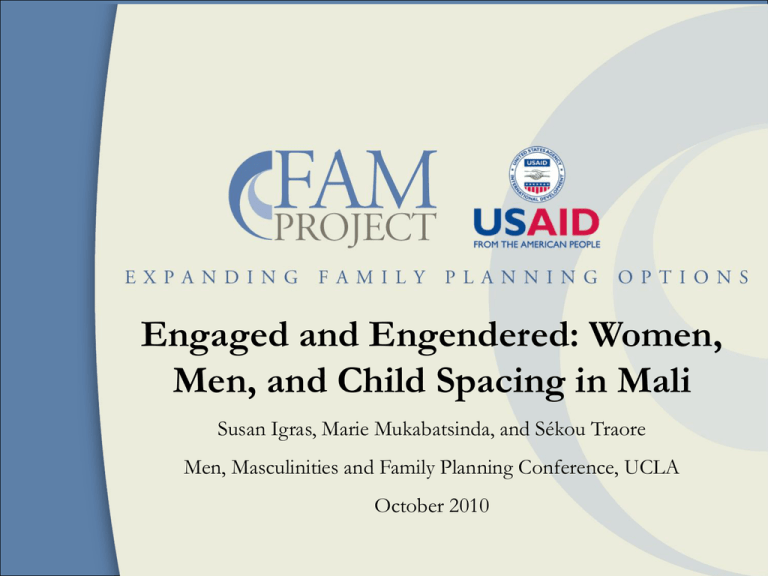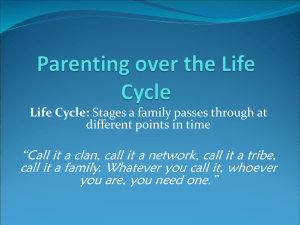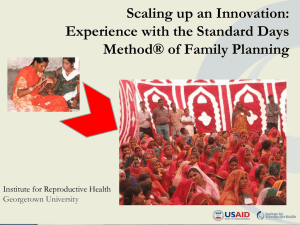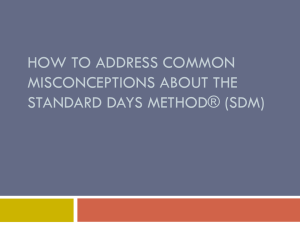
Engaged and Engendered: Women,
Men, and Child Spacing in Mali
Susan Igras, Marie Mukabatsinda, and Sékou Traore
Men, Masculinities and Family Planning Conference, UCLA
October 2010
SDM is an evidence-based practice
Operations
Research
2003- 2005
Pilot Studies
2000-2004
Method Concept &
Efficacy Trial
1999-2002
Integration
Studies
2005 - 2007
Scale-Up Case
Studies
2007-2012
SDM is really a set of evidencebased practices in scale up phase
Operations
Research
2003- 2005
Integration
Studies
2005 - 2007
Pilot Studies
2000-2004
Method Concept &
Efficacy Trial
1999-2002
• Male
engagement
• Couple
communication
• Couple services
Scale-Up Case
Studies
2007-2012
• Social diffusion
• Champions
• Advocacy
•Institutional’tion
Using Mali SDM Scale-Up
Assessment Data + other
country studies & take gender
lens to
• FP service provision
•
CAREF/IRH 2009
To What Extent is the
SDM Integrated into FP
Programs in Mali?
194 Facil assessments
Interviews with
278 providers
1,246 women/men id’d as
couples
• Women and men’s
attitudes in different
decision spheres
• Gender-equity interventions
Mali
Total Population: 12.9 m
CPR/mod methods: 6.9%
Unmet need : 31%
TFR : 6.6
IFS (women): 6.2 children
FP program since 1970s
Low use of health services,
particularly RH services
Great distances demand
institutionalized outreach
strategies by MOH
Why are women and men not
interested in using family planning?
(CAREF/ATN Evaluation of FP Campaign 2008)
Secondary effects
Rumors and misconeptions
•White dominance over Africans
•Money making scheme for whites
•Reduces sexual pleasure
•Favorises prostitution and adultery
•Sterility
Refusal of male partner in
using FP
Against religion
•Hidden FP use by woman
Views of service providers –
gendered, cultural, structural, or
otherwise determined?
Of those not offering the
SDM, top reasons why:
• Not trained in SDM
• Think method is complicated
• Think method not acceptable
to male partner
• Method not available at
health center
FP policies and program norms tend to
favor women
Do policies, norms and service standards
explicitly name men?
Are there explicit strategies for reaching men as
clients, within the couple, as community
change agents?
What might this mean in resource-constrained
environments such as Mali? MS/Div Sante de la Reprod
Guide pour l’engagement
constructif pour hommes
en sante de la reproduction
Janvier 2008
Partner Communication Matters:
Findings From an Analysis of 14 DHS Having
Female and Male Data
(Source: Gebreselassie, T, Spousal Agreement on Reproductive Preferences in Sub-Saharan Africa, Macro International, 2008)
Couple
agreement on
ideal no of
children
Couple
agreement on
having / not
having more
children
Overall reduction
in fertility
intentions of
both partners
(leading to
increased use of
FP)
Couple Counseling Results in Better
Continuation Rates
Baseline Data: Simulated Client Results (IRH/USA)
Interpersonal relations
Need diagnosis
Couple
Couplerelations
relations
Method options
Method characteristics
Side effects
Use instructions
Couple issues
issues and method
Couple
methoduse
use
Clinic environment
Clinic
environment
n=24 visits
0%
20%
40%
60%
80%
100%
How Can We Engage Couples More?
Couples-based services
• Programming is directed
towards couple
Couples-focused services
• Do not involve both
partners but address
issues related to the
relationship or male
partner
• Begins with an
individual female client
and may expand to
include partner
“She Says/He Says” Quiz to
facilitate RH discussion in couples
13
In a couple, who should make the
following decisions? (624 ♀, 624 ♂)
CAREF/IRH 2009
* p<.001
Couples do not always agree…Is it normal
for a husband to hit or beat his wife when -
* p<.001
(n=624 ♀, 624 ♂; CAREF/IRH 2009)
Couples don’t always agree…It is OK if the
wife refuses to have sex with her husband if
(n=624 ♀, 624 ♂; CAREF/IRH 2009)
* p<.001
If a woman refuses to have sex with her
partner, when he wants to, he has the right to
What do these differentials mean?
Decision-making power plays out differently
depending on decision.
Intimate decision-making around reproduction
may be more egalitarian than economic
decision-making in the Mali study.
Perceptions of sexual rights – of men, of women –
are paradoxical.
• Men seem to be giving women more power than they are
exercising.
• Women seem to think that men have more power than
men believe they have!
SOME APPROACHES TO
ENGAGE MEN AND WOMEN
IN NEW WAYS IN FP
Example: Engaging Men via Communitybased Water-Sanitation Program in El
Salvador
(Source: Lundgren et al, Cultivating Men’s Interest in FP in Rural El Salvador, Studies in FP 2005)
Messages: Reflected cultural context, values, and
conservation analogy to appeal to men
Work with leaders:
Water and sanitation
committees reached men
with FP info and referrals
Results after 18 mon
o Significant increases in KAB
o Demonstrated power of social
networks
Reaching men through
extension programs
in rural El Salvador
(Source: Gribble, J et al. Being Strategic About Contraceptive Introduction:
The Experience of the Standard Days Method, Contraception, 2008)
Messengers: Agricultural agents and
community volunteers reached farmers with
SRH info
Messages challenging behaviors/norms
using low literacy materials
stressing child health benefits of
birth spacing (plus violence, intimacy, etc):
Family planning use increased 37 – 55%
Supporting (male) religious leaders as FP
advocates in Mali and NE Kenya
• Health Policy Initiative-Mali:
Engaging local religious leaders
in deliberations, creating
consensus on role of FP in Islam
and their public actions.(This is not
training!)
• SDM is common ground - bidirectional gateway to modern
FP acceptability
• Results -6 mon/6 districts in
Kenya after similar activities:
>250 new FP/SDM users
(FHI,2009)
Social network diffusion by
engaged women in Mali
• Strategy: Talk to >4000 women
reached
by women’s savings club
clubs
members, supported by trained
educators, so FP acceptability
can diffuse
• Results in 1st phase 2008:
13% of women in savings clubs using modern FP versus
6% non-members. (CARE, 2009)
• Results in 2nd phase 2010: Affected health districts saw
after three months of network FP action, increases in FP
users above past new user trends (IRH, 2010)
FINAL THOUGHTS on closing
gender gaps and addressing unmet
• Need gender/social analysis and formative
research to identify actionable gender-equity
practices and outreach strategies and messages
for women and for men
• Social/gender norms shifts are incremental over
time. Identify where there is already a base of
agreement
• How to encourage women to use the space
already given to them by men?
• Experiment more with male-friendly and
couple-focused service delivery models in
facilities and community services to facilitate male
involvement
• More programming using community
mobilization and social networks approach










